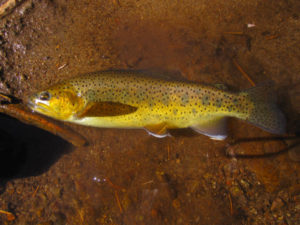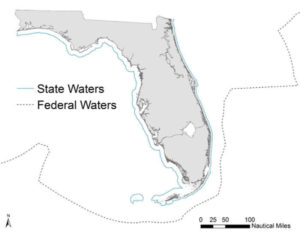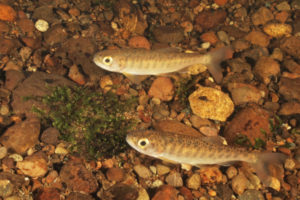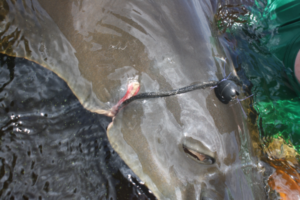Apache Trout
From near Extinction to EcoTourism
from The Fishing Wire
By Al Barrus, Public Affairs Specialist
U.S. Fish and Wildlife Service, Southwest Region

Male Apache Trout
After being stripped of its milt (fish semen) a male Apache trout swims among biologists in waders. The trout at Williams Creek National Fish Hatchery are farm raised, and spawned yearly.
For the uninitiated, Arizona may seem an unlikely fishing destination. When conjuring images of Arizona, the Grand Canyon and Saguaro cacti come to mind, not so much cold water brooks in alpine climes. However, as is the case with most things, Arizona isn’t so black and white. This state is home to many fishes. There is, in fact, one species here that can’t be found anywhere else in the world.
That is Arizona’s state fish: the Apache trout. Not normally occurring in large bodies of water, the Apache trout is native to the small, cool streams around the White Mountains of eastern Arizona. This species faced extinction due to competition from non-native trout, which were introduced for recreation.
Listed under the Endangered Species Act of 1973, the Apache trout is among those first species to gain federal protection. In 2000, the species was down-listed to threatened, opening the door to recreation. U.S. Fish and Wildlife Service Southwest Region fish biologists continue the work to restore this unique creature to its original habitat and to supply trout for recreation, as explains Zachary Jackson, the project coordinator and supervisory fish biologist for the Whiteriver station of the Service’s Arizona Fish and Wildlife Conservation Office.
“Several Service programs come together to further Apache trout conservation. The Ecological Services program works on threatened and endangered species issues. The Arizona Fish and Wildlife Conservation Office works to implement recovery actions working closely with our partners. The hatchery program also plays a role in sport fish production for Apache trout as well as producing an Apache trout stock that could be used for recovery purposes.
“Over the course of time, there were a number of threats to Apache trout. Maybe most significant there was probably some overfishing. They were very popular. Sport fish introduced into their range really constricted them to the headwaters of their native range. Those non-native trouts introduced for improved sport fishing opportunities have a few different interactions with Apache trout that negatively affect them.”
The Apache trout has very much become an underdog in it’s own neighborhood. Rainbow and brook trout were brought in: compete with Apache trout for food and space and interbreed with them. Complicating recovery further, rainbow, brook, and brown trout remain favorites for many recreational anglers. It can be difficult to convince outdoorsmen to give up a large game fish for a smaller trout that is listed as threatened.
“There’s hybridization that occurs that dilutes the Apache trout gene pool. There’s competition for food and space with Apache trout and that reduces their ability to increase in abundance and be robust, and then there’s direct predation by some of these non-native trout.”
With a coalition between federal, state, and tribal partners, recovery and conservation is moving forward. Hatcheries exist to not only ensure a strong gene pool for recovery of the trout, but also here at Williams Creek, fish are bred for the sole purpose of recreation.
Part of the recovery process involves removing the non-native trout from designated Apache trout habitat. A common way biologist remove unwanted species is through electrofishing, using voltage that attracts and temporarily stuns fish. They’re also using new technology to learn where to find those fish they need to remove.
“We’re coupling traditional or well-established fisheries techniques like barrier construction and maintenance to keep non-natives out of prime Apache trout habitat, and non-native removals using backpack electrofishing, with newer technologies like eDNA sampling.
“Environmental DNA sampling is a technique where we can collect a sample of water and filter out from that particles from tissue of different living organisms, and we can use DNA detections from specific location to target what we’re looking for. The way we use it is we look for non-native DNA in the water. And we take systematic sampling along a stream course that allows us to tell where brown trout are in a system and we usually don’t employ it until we think we’ve gotten the brown trout population really low. It allows us to find those few remaining individuals and target them for removal.”
While brown and rainbow trout are common game fishing staples throughout much of the U.S., Apache trout offer new opportunities for anglers the world over, who will come from far and wide to catch a fish that’s found only in the White Mountains of Arizona.
“Apache trout are important to the economy because there are a lot of folks who put a high value on capturing them, and so it brings in a lot of tourist dollars to the area which is very important for the White Mountain Apache Tribe. It also brings in tourist dollars to the surrounding area.”
“I think native trout enthusiasts are particularly interested in Apache trout because they’re very rare. They put the same value on them that we would put on diamonds, which are also extremely rare and beautiful.”
While the U.S. Fish and Wildlife Service is charged with recovering threatened and endangered species, and helping to provide recreational fishing opportunities is important to further conservation efforts, the Service’s role is very much a supportive one in the case of this unique trout.
“It’s critical for us to have a good strong relationship with the White Mountain Apache Tribe. They were the first stewards of Apache trout. They have been leading the conservation efforts since the beginning and our place here is in a supportive role. In everything thing that we do we’re coordinating very closely with them. With how and where we implement recovery actions we’re working with the tribe to constantly evaluate our wild populations and focus efforts where new threats arise. And without that partnership we wouldn’t be able to save the species.”
Williams Creek [NFH] hasn’t always been for the benefit of the Apache trout. Originally this hatchery was built to produce game trout for the tribe in the 1930s. The first year of operation attempted but failed to make Apache trout. It wasn’t until the 1980s that biologists were successful at breeding Apache trout at the hatchery.
Technology used at this hatchery is on the cutting edge. Williams Creek Fish Biologist Russell Wood explains some techniques they use to further the recovery of this fish.
“Apache trout are difficult to raise. They’re slower growing than the other species of trout due to a slower metabolism. They’re more susceptible to diseases which can make them difficult to raise.”
Today the hatchery staff manually spawned the trout. This process isn’t normally harmful for the fish, and they spawn yearly. An important part of keeping captive Apache trout is checking the ovarian fluid to check for disease. That comes out with the eggs. The males are also stripped of their sperm, which is called milt. The hatchery uses state-of-the art techniques to emulate a habitat that’s safe from predators and free of disease.
“This morning we were spawning Apache trout for production. Yesterday we sorted the female four-year-old Apache trout for ripeness. We had over a hundred ripe fish, so this morning we got in and we essentially knocked the fish out with a drug to make it safe to handle. Her eggs are hand stripped into a colander to drain the ovarian fluid off. They are then put into a bowl and the males are stripped of their milt for fertilization. And the eggs are water hardened for one hour, and then put away into the incubation stacks to incubate.”
The eggs and milt mix for a while, and then go on to become something greater than the sum of their parts: new Apache trout embryos. The hatchery is also using some newer techniques. They’re harvesting milt from wild Apache trout, and preserving in low temperatures, to enhance the stock that’s bred primarily for recreational fishing.
“This year for the first time we’re trying to introduced wild genetic material from the wild back into our hatchery population. Last year we went up into the mountains in the spring and spawned wild males, and we cryo preserved their milt. It’s a technology that’s been used for a lot of years in the livestock industry with cattle and horses. The milt was mixed with an extender and sucked up into small straws and essentially frozen on liquid nitrogen at minus 300 degrees fahrenheit. This fall we had the cryopreserved milt shipped back to us, and we’ve started utilizing it in our broodstock production by thawing this milt and fertilizing fish eggs with it in order to bring the wild genetics back into our population.”
Since Apache trout were so close to extinction, the gene pool is very limited. It’s difficult to match fish that aren’t closely related, and interbreeding makes the fish more susceptible to disease. To ensure healthy genetic pairing, they identify gene types and tag the fish with something similar to the electronic “PIT” tag that many people get for their pets, something about the size of a long grain of rice, that’s implanted under the skin.The Service has a sort of matchmaking service for Apache trout in Dexter, New Mexico.
“The genetics lab at the Southwestern Native Aquatic Resource and Recovery Center, their geneticists did a matrix for us. We took 50 of our females with passive integrated transponders (tags that have a 10 digit number similar to a social security number) and a fin clip and they did genetic work to match males to females that were not related, and some of our fish we are spawning this year for our brood stock replacement. We are utilizing this matrix which is mating a specific male to a specific female that are the most unrelated that we have for the purpose of the greatest genetic diversity to avoid inbreeding and breeding fish that are closely related to each other.”
While restoring a genetically robust Apache trout to its original habitat is the long-term goal of the Service, Russell Wood agrees that this fish is important for the local tribe and for anglers. And the fish could also become more popular with cooks and people who enjoy eating fish.
“The biggest importance to the tribe is people travel long distances just to catch an Apache trout, because they’re only found here. So it’s a revenue for the tribe to have people from out of state or out of town travel here spend money here to catch a fish they can only catch here. I need to eat one because I heard they’re delicious.”
“When we stock those fish in the Christmas Tree Lake here on the Reservation, the Tribe runs what’s called Trout Camp which is like a luxury camping trip with nice tents, catered by home cooked food and people pay money to spend a weekend fishing for these large Apache trout in Christmas Tree Lake and get taken care of by fishing guides and cooks.”
Russell has some tips for prospective Apache trout anglers.
“Catching Apache trout is going to be like catching any trout, and if you’re a fly fisherman use any of the flies that we have here. As for bait fisherman a good thing to use is a white powerbait. Use a small hook and very little weight and just let it drift in the current. When you see the white powerbait disappear it’s a fish’s mouth, and set the hook.
“Their native habitat is very small streams, high mountain streams that are crystal clear, cold, have lots of riffles, runs, and rapids. Some of them are not very wide. You can jump across them. It’s very pretty.”
Bradley Clarkson is a supervisory fish biologist at Williams Creek [NFH]. As both a U.S. Fish and Wildlife Service employee and a member of the White Mountain Apache Tribe, Bradley has a unique perspective in the conservation of the trout. He says the Apache people are proud to have this trout named for them.
“The Apache people in general, they like that. It represents them as an Apache tribal members. And they’re the ones that are protecting the land, so now at least we have 13 or 14 strains of this trout.”
Bradley says that the conservation of the Apache trout goes back centuries, to the time of Geronimo, who was a prominent leader of the Apache (Chiricahua) from the mid-19th to the early 20th century, and enforced conservation during the time of westward expansion.
“I think Geronimo too had something to do with that as well. He would keep people away, even us White Mountain Apache kept our distance, when he was around we were afraid of him as well. My grandmother mentioned one time, her mom said when Geronimo is coming they would want to go higher up in the mountains.
“They feared him. If we feared him I’m pretty sure other folks feared him more that’s how I believe he protected the land and the natural resources. The White Mountain Apache Tribe as well, when the trout became endangered, they made it a wilderness area where you can’t even take in a slingshot, much less a fishing pole without getting cited.”
There’s also a measured return in investment in the important conservation work that the Service and the Tribe do in working together to restore the trout.
“For every dollar gets put into to the hatchery, the nearby communities get $19 back. And the future looks good because right now as the staff here at Williams Creek we finally got to where we can go out into the White Mountains, and the tribe give us permission to go in there and collect wild genetics to bring back and put in our brood stock. We’re not going to see it the change this year, but maybe two or three years down the road because we are finally getting our genetics put back into our spawning.”
For Bradley, a major aspect of this work is passing the torch to future generations.
“When my supervisors send me to the Native American meetings with other tribes I suggest to bring some expertise to the hatchery and some training for our youth. The most important skill for them to learn is cryopreservation, because that’s what we’re doing. Maybe some of our Apache tribal members can learn to do in the field, and they could pick it up and introduce it to the hatchery education program at the school.
“That’s one of our goals, we’ve been trying to recruit Apache tribal members by going and tapping into their high school and going to their instructors and biology teachers and asking and looking for the best candidate? Who has the potential?’ That’s how I get help, by finding who are good students to pick from. We only have so many spots here, but we can interview them and get them ready, and find out who’s really going into this field.
“Because I’d really like to see some Apache tribal member continue the hatchery work and from where I’m at right now and be dedicated and have a passion for the Apache trout program.
“That’s the reason why I’m still here 25 years later, because I really like to contribute to the Apache trout program, and when I’m done I’d like to say to the Apache people ‘Hey I’m done now. Your turn. This is as far as I can go. Now I go rest, and maybe go fishing.”
-30-
Information about White Mountain Apache Tribe’s Trout Camp: https://www.wmatoutdoor.org/
Video – Watch Williams Creek Fish Biologist spawn Apache trout – https://www.facebook.com/USFWSSouthwest/videos/2094681363915423/
All photos by Al Barrus





